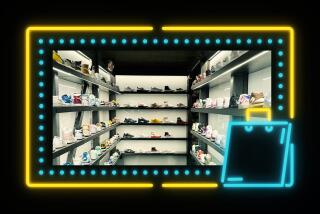Taking Advantage of Montana Way of Life : Marketing: Businesses that produce outdoor goods with the emphasis on quality, not price, are racking up sales.
- Share via
SWAN LAKE, Mont. — Canoe maker Greg Morley set up shop here in 1975 because this little pocket of northwestern Montana fits the way he and his wife like to live. The pace is slow, the land spectacular, and it is lake country.
Morley, who left a job as a planner for the Oregon park system to make cedar-strip canoes, is a member of a growing industry in Montana: outdoor products that sell on quality, not on price.
The people who run these businesses revel in the Montana way of life. So do many of their customers, even if they live far away.
“Some people get the feeling that they’re buying our lifestyle a little bit,” said Morley, who makes 15 to 20 canoes a year at his shop along the highway through Swan Lake, south of Glacier National Park.
People pay $3,000 for a Morley canoe, and that’s also characteristic of Montana outdoor products. They tend not to show up at the local discount store.
Montana businesses produce sleeping bags; hunters’ backpacks made of fleece; foldable chairs that fit in backpacks; dog sleds; boots guaranteed to keep your feet warm, and more.
In Twin Bridges, the R.L. Winston Rod Co. serves an elite market worldwide. A graphite fishing rod sells for $475, and those made of bamboo bring $1,750.
“There is a mystique to Montana products,” said Gene Marceil, director of the Montana Small Business Development Center. “When you say ‘Montana,’ it immediately brings thoughts of high quality, because people think of the air, the sky. They think that if you live in Montana, you must do good work.”
Donna Hermann of Corpus Christi, Tex., doesn’t argue with that.
She is thrilled with the Morley canoe that she bought during the summer, two years after rain idled her Glacier vacation and she headed off to the little shop in Swan Lake.
“I think everyone is struck with the canoes’ beauty first, and then they find out how well they work,” Hermann said.
Other Montana products also are best-sellers that don’t come cheap.
In Bozeman, the most popular backpack from Dana Design costs more than $400.
“Usually it’s not someone’s first pack, I must admit,” said Dana Gleason, the president. “Usually they have to see for a few days, or a whole season, how bad a load can hurt before they want to spend $400.”
Dana Design, begun in 1985 with a $12,000 loan, became so attractive that it was bought by Los Angeles-based Anthony Industries, which includes companies that make Olin skis, Shakespeare fishing gear and Stearns life jackets.
In Red Lodge, Crazy Creek Products turns out 13 models of the folding, lightweight chair that Rob Hart began making as a climbing guide in 1986.
The chair took off, and Hart now employs 48 people at a production facility in Red Lodge. The chairs, selling from $37 to $73, are available at 1,500 outlets and by mail.
Backpackers were the first market, then hunters. Sports booster clubs began buying the chairs for stadiums, and now they’re touted for beach use. An advertisement in Smithsonian magazine invites people to “sit anywhere in comfort.”
Hart, 38, would like to create more products and see the company grow, but his outdoor pursuits take him all over the world, and he doesn’t intend to be tied down by business.
“I’m working on an MBA--management by absence,” he said.
At Three Dog Down in Polson, Bob Ricketts sells down-filled products, including a $350 sleeping bag called “The Bob,” after the nearby Bob Marshall Wilderness Area. The company makes its bags at Polson and Missoula, with 15 to 30 in production at a time.
In Bigfork, Molly Strong-Butts turns out $250 boots, one custom pair at a time, with the help of one assistant.
“I’m an outdoor person who worked outdoors,” she said. “Nothing I bought, especially in footwear, kept me warm.” Slipping on ice was another problem.
So, Strong-Butts designed her own lightweight, washable boots, with air space for warmth and a traction sole that she said is a trade secret.
She said she needed financial backing and could not get satisfactory deals with the boot companies that she approached. Now she has an agreement with some investors on the East Coast, and expects production to begin this winter.
“When we learn how to run the machines, we will build a Montana plant,” said Strong-Butts, who intends to continue product research in Bigfork.
More to Read
Sign up for The Wild
We’ll help you find the best places to hike, bike and run, as well as the perfect silent spots for meditation and yoga.
You may occasionally receive promotional content from the Los Angeles Times.






